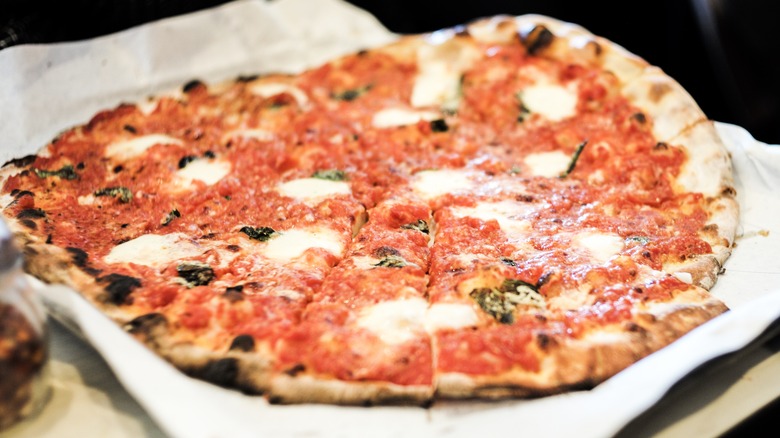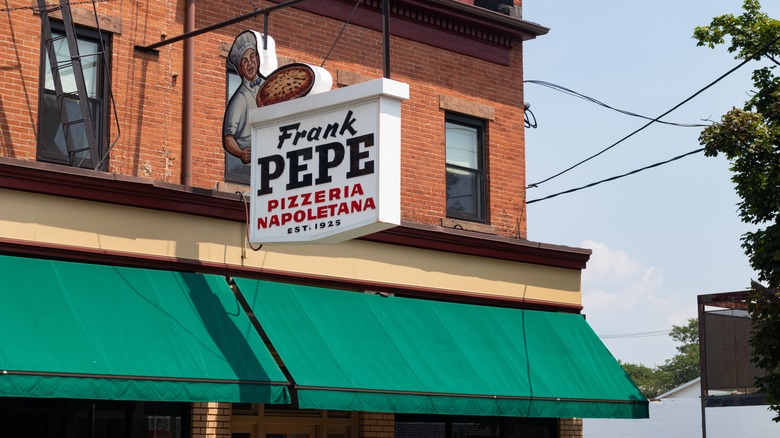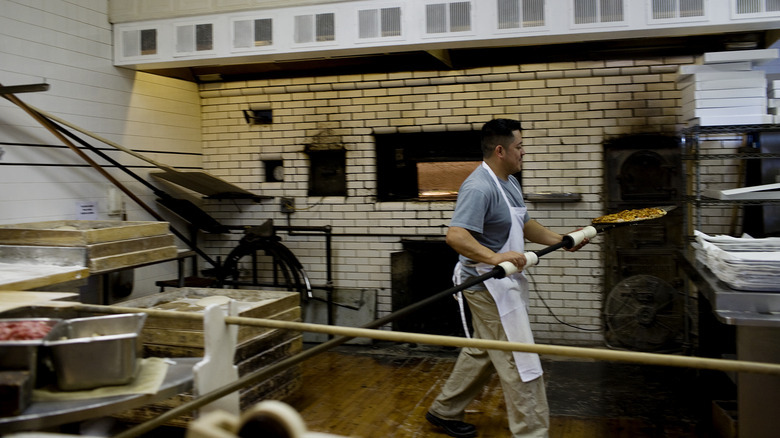What You Need To Know About New Haven-Style Pizza
New Haven, Connecticut's population is a fraction of New York's, but its pizza is a legitimate challenger to the Big Apple when it comes to America's finest. Despite their relative geographical closeness, these two cities have birthed very different styles of pizza, with the only real resemblance being their thin crusts. However, both share a similar history through the influence of Italian immigration.
There are three main factors that make New Haven-style pizza unique: the crust, the cheese, and the oven. Connecticut's offering is made with an extremely high-hydration crust, typically around 70%. This means that the dough is made with 70% as much water as flour, making it so wet that you can barely even knead it. Instead, the gluten is developed through a lengthy fermentation period. This makes the crust airy and enhances its flavor beyond standard thin-crust pizzas. Unlike other pizza styles, New Haven's doesn't have a big handle of crust at the edge to grip, with the sauce going almost to the edge.
New Haven's pizza also stands out for its toppings. The standard base is tomato sauce and pecorino cheese. Mozzarella is considered an additional topping rather than a given. Lastly, there's the oven — coal-fired and heated to nearly 1,000 degrees Fahrenheit. At such a high temperature, the pizza cooks very quickly, becoming super crispy and charred. A New Haven-style pizza should never, ever flop at the tip.
The origins of New Haven-style pizza
The history of New Haven-style pizza begins in the 1910s when a wave of Italian immigrants settled in the Elm City. They primarily came from Southern Italy, specifically Sicily and Naples, the latter of which is famous for being the birthplace of modern pizza. The thin crust, high-heat methodology is directly inspired by those legendary Neapolitan pies. The use of coal-fired ovens was also established in these early days, as coal was particularly affordable at that time.
It's difficult to determine where the first New Haven-style pizza was made (and by whom) because they probably didn't come from commercially licensed restaurants. Instead, it's believed that Italians operating bakeries began adding pizzas to their repertoires. Some even baked pizzas and then took them to the streets, posting up near businesses to feed workers.
One of the first known makers of New Haven pizza was Ignazio Camposano, who began selling it at his bakery in 1917 before opening a restaurant in 1924. One year after that, Frank Pepe, a native of Maiori, Italy, opened his namesake restaurant, which became arguably the most famous pizzeria in New Haven, firmly establishing the model upon which the city's pies are based. Frank Pepe Pizzeria is still going strong as the oldest of New Haven's "Big Four" pizzerias. The other three are Sally's Apizza, Modern Apizza, and the newest member of the list, BAR. Both Frank Pepe's and Sally's sit on Wooster Street, a historical center for Italian-American culture.
New Haven pizza lingo
New Haven's pizza stands out for more reasons than the actual pie itself. There's a unique set of terms that you're supposed to use when talking about this style. In fact, we've been breaking one of those rules throughout this whole article: New Haven-style pizza isn't actually called pizza; it's properly known as "apizza," pronounced "a-beetz," which harkens back to the word used by the original Neapolitan immigrants who pioneered this style.
As previously mentioned, mozzarella is not used as the standard base of a New Haven pie, and most restaurants will make you order it as an additional topping. In this case, it is classically referred to by the abbreviated "mootz," and depending on the pizzeria you go to, you may need to order "with mootz" or "no mootz."
Lastly, you should never, ever critique a New Haven apizza as burnt. It's charred. Thanks to the ripping hot fire in those coal ovens, the crust is supposed to have a generous degree of black spotting around the edge. Those extra crispy patches are evidence of the Maillard reaction, the same chemical process that puts a nice sear on your steak and a brown crust on a baguette. As with both of those foods, the Maillard reaction adds an extra layer of flavor to New Haven's apizza. It's the perfect note to end each slice on.


